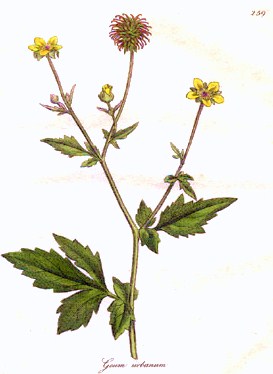
Geum urbanum (L)
 Synonyms and Common names: Radix caryophyllata, Wood Avens, City
Avens, European Avens, Yellow Avens, Star of the Earth, Wild rye, Way Bennet,
Herb Bennet, Colewort, Goldy star, Goldy stone, Clove root, Benedict's herb,
Blessed Herb
Synonyms and Common names: Radix caryophyllata, Wood Avens, City
Avens, European Avens, Yellow Avens, Star of the Earth, Wild rye, Way Bennet,
Herb Bennet, Colewort, Goldy star, Goldy stone, Clove root, Benedict's herb,
Blessed Herb
German = Nelkenwurz, French = Herb de St. Benoit, Italian = Ambretta salvatica, Spanish = Gariofilea
Order: Rosaceae
Description: Geum is a native British perennial, also found over much of Europe and Central Asia. It grows up to 60cm tall and has an erect, slightly branched stem. The basal leaves are stalked, toothed and segmented, becoming smaller further up the stem. A few five-petalled yellow flowers arise at the tip of each branch, the pointed sepals visible between each pair of petals. Hairy hooked carpels remain as a sessile head in fruit. This herb is common in gardens, hedges, ditches, open woodland and in waste places. It flowers from May to October.
Parts used: aerial parts and root
Collection: The roots are collected in spring when they are richest in volatile oils. The aerial parts are collected in July when the flowers are at their best.
Constituents: essential oils, phenolic glycosides (including gein and eugenol), tannins, bitter principle, flavones, resin, organic acids
Actions: antidiarrhoeal, antihaemorrhagic, febrifuge, astringent, styptic, diaphoretic, antiseptic, aromatic, tonic, stomachic, anti-inflammatory. The root is a mild sedative and hypnotic.
Indications: ulcerative colitis, diverticulitis, diarrhoea, catarrhal colitis, passive uterine haemorrhage, intermittent fevers.
Therapeutics and Pharmacology: Geum combines bitter-tonic properties with the astringent effects of its tannins and the antiseptic action of its volatile oil eugenol which is also found in cloves and allspice. Its powerful astringency give Geum its role in many intestinal problems such as diarrhoea, dysentery, mucous colitis, etc. It helps to settle nausea and allay vomiting and it promotes appetite, acting as a tonic during convalescence. Eugenol increases the activity of the digestive enzyme trypsin, while the bitter component helps regulate liver and gallbladder function. Geum's astringency also explains its use as a mouthwash or gargle in the treatment of gingivitis, halitosis and sore throats. It is considered an excellent remedy for fevers and has been substituted for quinine in the past. As a douche, it is helpful in the treatment of leucorrhoea. The root may be used as a sedative, although its action is much less potent than Valeriana root.
Combinations: Geum may be combined with Agrimonia and/or Bidens in colitis.
Preparation and Dosage: (thrice daily)
Not listed in the GSL
Dried herb: 1-4g
Liquid extract: 1:1 in 25% alcohol, 1-4ml
Additional Comments: Paracelsus recommended Avens for catarrh of the stomach and intestines and diarrhoea. The botanical name, Geum, originated from the Greek geno, meaning to give an agreeable fragrance; the freshly dug root has a clove-like aroma. Its other botanical name, Radix caryophyllata, means Clove root, and it was often used as a substitute for cloves in the past. It's saintly common names refer to the fact that it was often worn as an amulet to ward off evil spirits and venomous beasts. In mediaeval times the trefoil leaf and the five golden petals represented the Holy Trinity and the five wounds of Christ, and the plant often occurs in the architectural detail of columns and in wall patterns. The roots were often used to flavour beer and to place among linen as a moth repellent. They were also chewed to prevent bad breath. The whole plant has been used as a quinine substitute.
Bibliography
Bartram, T. 1995 Encyclopedia of Herbal Medicine, 1st edn., Grace Publishers, Bournemouth.
Bremness, L. 1994 Herbs, Dorling Kindersley Eyewitness Handbook, London.
BHMA 1983 British Herbal Pharmacopoeia, BHMA, Bournemouth.
Chevallier, A. 1996 The Encyclopedia of Medicinal Plants, Dorling Kindersley, London.
Grieve, M. 1931 A Modern Herbal, (ed. C.F. Leyel 1985), London.
Hoffmann, D. 1990 The New Holistic Herbal, Second Edition, Element, Shaftesbury.
Lust, J. 1990 The Herb Book, Bantam, London.
Mabey, R. (ed.) 1991 The Complete New Herbal, Penguin, London.
Mills, S.Y. 1993 The A-Z of Modern Herbalism, Diamond Books, London.
Newall, C.A., Anderson, L.A., & Phillipson, J.D. 1996 Herbal Medicines: A Guide for Health-care Professionals, The Pharmaceutical Press, London.
Prihoda, A. 1989 The Healing Powers of Nature, Octopus, London.
Weiss, R.F. 1991 Herbal Medicine, Beaconsfield Arcanum, Beaconsfield.
Wren, R.C. 1988 Potter's New Cyclopaedia of Botanical Drugs and Preparations, C.W.Daniel, Saffron Walden.










